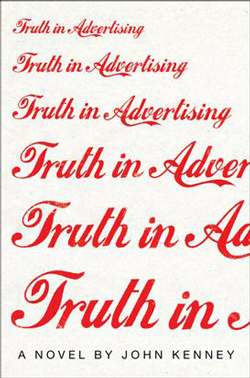Truth in Advertising
by John Kenney
reviewed by Andre van Loon
“You are not the kind of guy who would be at a place like this at this time of the morning. But here you are . . . ” These are the opening lines of Bright Lights, Big City, one of the most famous novels about the intoxicating challenge of New York. The city here is a glamorous, transformative place: Experience, Love, and Wealth its glittering prizes. Yet there is also a sharp sense of unreality—you are not the guy who should be here—and much that initially attracts begins to repel McInerney’s protagonist. In the end, the young man achieves morally the most by feeling at his worst.
John Kenney, in his debut novel Truth in Advertising, partly updates Bright Lights, Big City to the 2010s. Instead of following a pained young fact-checker, we follow a pained middle-aged copywriter, similarly edging his way towards a moral dawning. It is tempting to think of Kenney struck, like many others, by McInerney’s eighties debut novel and waiting until now to try to rival him. The essential narrative in both novels is the same, moving from unreality and enjoyment to sobriety and loss. The difference lies in the detail, in Kenney’s humor—McInerney does not really aim to make you laugh—and in the exploration of how to be genuine.
Truth in Advertising’s Finbar Dolan is a moderately successful copywriter working for a Madison Avenue ad agency. He remembers coming to the city as a youth: “Those first years were, for me, unlike anything I had ever known. . . . Everything seemed possible. This is your life, you think.” Fin enjoys advertising’s glamour and is easily seduced by a life of expense accounts and flamboyant personalities. But some of those he works with live and breathe their work; they have an innate talent that often wins the day. Fin learns, over the years, what it is to lose, to rise only so far and no further.
The disappointed idealist becomes not a realist but a humorist. Fin sees the absurdity in working for a client who commissions an ad to herald a breakthrough—the first biodegradable diapers in history. Much effort is expended on making something for a Super Bowl premiere, until the client admits the nappies could be biodegradable; testing is ongoing. Later, Fin argues with his bosses and thinks about quitting. A colleague tells him, “I’ll quit too. A symbol of my loyalty. We’re a team. We’ll freelance. Even though there is no freelance. Or we’ll get great jobs at another agency. Even though there are no jobs anywhere. Maybe I won’t quit. You’re on your own. I wish you the best.” Truth in Advertising contains lots of dialogue like this: self-referential, ironic, knowing banter that can be heard in many popular films, sitcoms, and novels.
Then we have the family story. The unhappy family is a lasting preoccupation of American and British fiction. Growing up with troubled parents sets one up, in this cultural context, for a lifetime of anxiety. No member of the Walton or Ingalls family is easily imagined as working on Madison Avenue. Those who do well there tend to be deeply flawed characters, like Mad Men’s Don Draper, cursed by quite the wrong childhood. And so it is in Truth in Advertising. Fin comes from a home blighted by domestic violence. Fin’s father, a WWII submarine veteran, was damaged goods upon returning from the war; he became a police officer out on the street but a wife beater at home. Over the years, this alienated the siblings first from their parents and then from each other. Once in New York, Fin sets out on his own path, making as many close friends as he can, including Phoebe, the girl he hopes he will never lose, before he learns that his father is seriously ill in hospital.
Does the novel work? Yes and no. When it does, it is genuinely funny. Some of the absurd situations are very close to advertising’s bone, and the banter, despite its cultural ubiquity, is well-placed and an authentic part of the story. The friendships portrayed are believable and help us like the main character a bit better; someone who laughs at everything is not easily lovable. As for the family story, it is clearly meant to be hard-hitting and tragic, and at the start, it is. But this side of the novel goes wrong by being too fully exposed and too often returned to. Insistence, reiteration, even of things we should really care about, can start to wear on the reader. Kenney, though skillful in his interesting debut, ultimately proves once again how hard it is to write a great Manhattan novel.
Published on November 8, 2014

